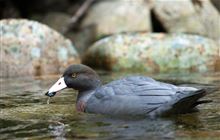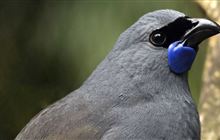Welcome milestone in whio numbers in Kahurangi National Park site
Archived content: This media release was accurate on the date of publication.
Introduction
Whio numbers in the Wangapeka-Fyfe Whio Security Site in Kahurangi National Park have surpassed the targeted 50 pairs and climbed to 79 pairs after 18 years of predator control and management.Date: 29 April 2021
When the whio security site was started in 2003, with the first 3.6 kilometres of trapline installed on the Rolling River, just one whio pair was found across 10 kilometres of waterway. The Wangapeka-Fyfe Security Site now encompasses 1078 stoat traps along 85 kilometres of the Wangapeka, Fyfe, Rolling and upper Karamea rivers.
“It’s a huge milestone to not only achieve but exceed our goal of 50 pairs,” says DOC Motueka Senior Biodiversity Ranger Kate Steffens, who became involved in the security site in 2006, leading installation of the trapline on the Fyfe River in snow. It began her passion for whio.
“We’ve been able to achieve this thanks to the support of Genesis through the Whio Forever programme, the Isaac Conservation and Wildlife Trust, and the contractors and community volunteers who do the hard yards with us to maintain the traps,” she says.
“The support of Genesis since 2011 enabled our stoat trapping network to be extended and intensified and it assisted the Whio Operation Nest Egg (WHIONE) programme to boost whio numbers. Through the WHIONE programme eggs were taken from wild pairs and the ducklings hatched and raised in a wildlife centre for release into the security site.”
Genesis Group Manager Sustainability, Courtney Simpson, said the dedication of the DOC team and commitment of community volunteers was at the heart of the programme’s success.
“Genesis has been a partner of The Whio Forever since 2011 and results like this are good news for all New Zealanders. The whio is a river specialist and an iconic back-country species and we are pleased to play our part in helping boost its numbers.”
Kate Steffens says the support of the Isaac Conservation and Wildlife Trust has been instrumental in growing the whio population.
“It started with hatching and raising ducklings for the WHIONE programme. Since 2018, it has continued with a ‘breed for release’ programme in which pairs at the Isaac facility and other wildlife centres produce whio for release in the Wangapeka-Fyfe site and other South Island rivers.
“I recall frosty mornings of thawing my boots out with warm water to get them on my feet, having to carefully carry whio eggs down the track and across rivers to go to Isaac’s, and watching hours of video footage of whio incubating eggs and anxiously hoping not to see predators visiting the nest,” says Kate Steffens.
“We have put our heart and soul into the project and while getting to 79 pairs is an achievement for whio, it’s also a highly rewarding achievement for all of us who have worked to protect the whio and grow their numbers.”
Whio are vulnerable to stoat predation so the trapping network has been essential for protecting the ducks.
Aerial 1080 predator control operations have also provided critical additional protection in years when rat and stoat numbers surge due to beech seeding. Duckling numbers spiked following aerial 1080 operations which reduced stoat numbers.
Background Information
Wangapeka-fyfe whio security site
- After a 2011 OSPRI aerial 1080 operation, 48 whio ducklings were recorded. After DOC aerial 1080 predator control operations in 2014 and 2016, 65 and 40 ducklings respectively were recorded. In other years, 21, 18, 23, 28 and 22 whio ducklings were counted.
- Tapawera Area School students and locals along with people from the Motueka, Richmond and Nelson communities maintain frontcountry traplines.
- Contractors employed to assist DOC rangers in maintaining the backcountry traplines have included Kaitiaki O Ngahere and Nelmac and currently MBC Environmental Solutions.
More about whio
- The whio is a threatened species of native duck only found in New Zealand’s fast flowing waters. Featured on New Zealand’s $10 note and with an estimated population of less than 3000 birds, whio are rarer than kiwi.
- Whio are adapted to live on fast-flowing rivers. Finding whio means you will also find fresh, fast-flowing water with a good supply of plants and underwater insects.
- This makes whio important indicators of ecosystem health – they only exist where there is quality fresh water and an abundance of life.
More about Whio Forever
- Genesis has a strong historic association with whio through the Tongariro Power Scheme. In 2010 this association grew through the establishment of Whio Awareness Month (March).
- Today, Genesis and DOC continue their partnership through The Whio Forever Project, which aims to secure the future of whio in the wild and ensure New Zealanders understand and value whio in our rivers.
- The support of Genesis and the work of DOC has enabled the Whio Recovery Plan to be implemented.
Conservation issue
- The whio are predated by stoats, ferrets and cats with the largest impact during nesting time when eggs, young and females are vulnerable, and also when females are in moult and can’t fly.
- Extensive trapping can manage these predators and work in key whio habitats by DOC and Genesis on the Whio Forever Project has already seen an increase in whio numbers.
- Whio cannot be moved to predator-free islands like other species because of their reliance on fast-flowing rivers.
- Pairs occupy approximately 1km of water – so they need a lot of river to sustain a large population and they fiercely defend their territories, which makes it difficult to put them with other ducks in captivity.
- They are susceptible to flood events which, destroy nests, fragment broods and wash away their valued food source.
Contact
For media enquiries contact:
Email: media@doc.govt.nz



